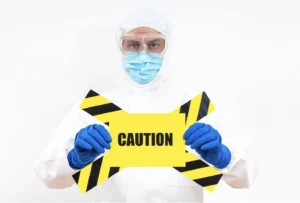Prioritizing Safety in Manufacturing in India with ISO 45001
Occupational safety is a paramount concern in the manufacturing sector, where workers face various risks and hazards on a daily basis. Ensuring a safe working environment not only protects employees’ well-being but also contributes to the overall efficiency and productivity of manufacturing operations. In India, where the manufacturing sector plays a crucial role in driving economic growth, prioritizing safety is imperative. ISO certifications are crucial in the manufacturing sector as they ensure quality, safety, and efficiency, meeting global standards and boosting credibility. One effective way to achieve workplace safety is by implementing internationally recognized safety standards such as ISO 45001.
Understanding ISO 45001:
ISO 45001 is a globally recognized Occupational Health and Safety Management System standard designed to help organizations proactively manage occupational health and safety risks. It provides a framework for establishing, implementing, maintaining, and continually improving an organization’s occupational health and safety management system. Key principles of ISO 45001 include leadership commitment, worker involvement, hazard identification and risk assessment, and continual improvement. By obtaining ISO 45001 certification, manufacturing companies can demonstrate their commitment to ensuring a safe and healthy work environment for their employees.
Benefits of ISO 45001 Implementation:
Implementing ISO 45001 offers numerous benefits for manufacturing companies:
- Enhanced Safety Culture: ISO 45001 promotes a culture of safety throughout the organization, leading to increased employee awareness and participation in safety initiatives.
- Reduced Incidents and Accidents: By systematically identifying hazards, assessing risks, and implementing control measures, ISO 45001 helps reduce the likelihood of workplace incidents and accidents.
- Legal Compliance: ISO 45001 ensures compliance with relevant occupational health and safety regulations, helping manufacturing companies avoid legal penalties and fines.
- Improved Efficiency and Productivity: A safer work environment leads to fewer disruptions, improved morale, and increased productivity among workers.
- Competitive Advantage: ISO 45001 certification enhances a company’s reputation and credibility, making it more attractive to customers, suppliers, and stakeholders.

Occupational Safety Challenges in the Indian Manufacturing Sector
Common safety hazards and risks faced by manufacturing workers:
In the Indian manufacturing sector, workers are exposed to various safety hazards and risks, including:
Physical hazards such as machinery accidents, falls, and ergonomic injuries:
- Machinery accidents: Workers in manufacturing facilities are often exposed to heavy machinery and equipment, increasing the risk of accidents such as entanglement, crush injuries, and amputations. Improper use, lack of training, and equipment malfunctions can contribute to these hazards.
- Falls: Elevated work areas, slippery surfaces, and inadequate fall protection measures pose a significant risk of falls in manufacturing environments. Falls from heights or on the same level can result in serious injuries, including fractures, concussions, and spinal cord injuries.
- Ergonomic injuries: Poor ergonomic design of workstations, repetitive tasks, and manual handling of heavy loads can lead to musculoskeletal disorders such as strains, sprains, and carpal tunnel syndrome. These injuries can result in chronic pain, reduced mobility, and decreased productivity among workers.
Chemical hazards from exposure to hazardous substances and materials:
- Chemical hazards are prevalent in manufacturing industries where workers come into contact with various hazardous substances and materials, including solvents, acids, pesticides, and heavy metals.
- Exposure to these chemicals through inhalation, skin contact, or ingestion can cause a range of health effects, including respiratory problems, skin irritation, neurological disorders, and even cancer.
- Proper handling, storage, and disposal of chemicals, as well as the use of personal protective equipment (PPE) such as gloves, goggles, and respirators, are essential to minimize the risks associated with chemical exposure.
Biological hazards in environments with potential exposure to viruses, bacteria, and other pathogens:
- Manufacturing facilities that handle biological materials, such as pharmaceuticals, healthcare products, and food processing plants, face the risk of exposure to viruses, bacteria, fungi, and other microorganisms.
- Workers may be exposed to infectious agents through direct contact, inhalation of airborne particles, or ingestion of contaminated food or water.
- Implementing proper hygiene practices, maintaining clean and sanitary work environments, and providing appropriate PPE and vaccination programs can help prevent the spread of infectious diseases in manufacturing settings.
Psychosocial hazards such as stress, fatigue, and workplace violence:
- Psychosocial hazards refer to factors in the work environment that affect workers’ psychological well-being and mental health.
- Stress and fatigue can result from high workloads, long hours, job insecurity, interpersonal conflicts, and lack of support from management.
- Workplace violence, including verbal abuse, harassment, intimidation, and physical assault, poses a significant risk to employee safety and can have long-lasting effects on mental health and job satisfaction.
Electrical hazards due to faulty wiring, overloaded circuits, and improper use of electrical equipment:
- Electrical hazards are prevalent in manufacturing facilities where workers interact with electrical systems, machinery, and equipment.
- Common electrical hazards include exposed wires, damaged insulation, overloaded circuits, and faulty equipment.
- Workers may be at risk of electric shock, burns, fires, and explosions if proper precautions are not taken, such as using grounded electrical systems, performing regular inspections and maintenance, and following safe work practices when working with electricity.
 Regulatory framework and compliance issues in India:
Regulatory framework and compliance issues in India:
While India has regulations in place to ensure occupational health and safety, compliance with these regulations remains a challenge for many manufacturing companies. The regulatory framework includes laws such as the Factories Act, 1948, and the Occupational Safety, Health and Working Conditions Code, 2020. However, enforcement mechanisms are often inadequate, and many companies struggle to meet the requirements due to resource constraints, lack of awareness, and bureaucratic hurdles.
Impact of safety lapses on worker health, productivity, and business reputation:
Safety lapses in the manufacturing sector can have severe consequences, including:
1. Worker health issues ranging from minor injuries to fatalities, leading to increased healthcare costs and absenteeism:
- Injuries and fatalities in the workplace can have significant consequences for workers’ health and well-being. Minor injuries such as cuts, bruises, and sprains may require medical attention and time off work for recovery, resulting in increased healthcare costs and absenteeism.
- More severe injuries, such as fractures, amputations, and traumatic injuries, can have long-term effects on workers’ physical and mental health, potentially leading to permanent disabilities, chronic pain, and psychological trauma.
- Fatalities resulting from workplace accidents are tragic and devastating for workers’ families and communities. They also impose financial burdens on employers in the form of
compensation payouts, legal fees, and potential lawsuits.
2. Reduced productivity due to work stoppages, disruptions, and employee morale issues:
- Work stoppages and disruptions caused by workplace accidents, injuries, or safety incidents can lead to significant productivity losses for manufacturing companies. When production lines are halted, orders are delayed, and deadlines are missed, it affects the company’s ability to meet customer demands and fulfill contractual obligations.
- Even minor incidents or near misses can disrupt workflow, decrease efficiency, and create distractions in the workplace. Additionally, dealing with the aftermath of accidents, such as conducting investigations, implementing corrective actions, and addressing employee concerns, can divert resources and attention away from core business activities.
- Employee morale issues, such as fear, anxiety, and distrust, can arise following safety incidents, particularly if workers perceive that management is not prioritizing their safety or addressing their concerns. Low morale can lead to decreased motivation, job satisfaction, and engagement, further impacting productivity and performance.
3. Damage to the company’s reputation, loss of customer trust, and potential legal liabilities in case of accidents or regulatory violations:
- Workplace accidents, injuries, and safety incidents can tarnish a company’s reputation and erode customer trust, especially if they receive negative media coverage or public scrutiny. Customers may perceive a company with a poor safety record as untrustworthy, unreliable, or negligent, leading to loss of business and market share.
- Moreover, regulatory violations or non-compliance with safety standards can result in fines, penalties, and legal liabilities for manufacturing companies. Failure to adhere to occupational health and safety regulations may expose companies to lawsuits, settlements, and enforcement actions by regulatory authorities, further damaging their reputation and financial standing.
Proactive measures to prioritize safety, implement robust safety management systems, and demonstrate a commitment to workplace safety can help mitigate these risks and safeguard the company’s reputation, customer relationships, and legal standing.

The Role of ISO 45001 in Enhancing Safety Practices
Framework for establishing a robust safety management system:
- ISO 45001 provides a comprehensive framework for organizations to develop and implement an effective occupational health and safety management system (OHSMS). This framework is based on the Plan-Do-Check-Act (PDCA) cycle, ensuring a systematic approach to managing safety.
- The standard requires organizations to establish policies, objectives, and processes to identify hazards, assess risks, and implement controls to eliminate or mitigate safety risks in the workplace.
- By establishing clear roles, responsibilities, and accountabilities for safety management, ISO 45001 helps organizations create a culture of safety and accountability throughout the organization.
- Implementation of ISO 45001 involves defining safety objectives, conducting hazard assessments, developing safety procedures, and establishing performance metrics to monitor and measure safety performance.
Integration of risk assessment, hazard identification, and incident reporting:
- ISO 45001 emphasizes the importance of proactive risk assessment and hazard identification as fundamental components of an effective safety management system.
- Organizations are required to conduct regular risk assessments to identify potential hazards, evaluate the associated risks, and implement appropriate controls to prevent accidents and injuries.
- The standard also mandates the establishment of incident reporting procedures to ensure timely reporting, investigation, and resolution of safety incidents. Incident investigation findings are used to identify root causes, implement corrective actions, and prevent recurrence of similar incidents in the future.
- By integrating risk assessment, hazard identification, and incident reporting processes, ISO 45001 helps organizations create a culture of continuous improvement in safety performance and compliance.
Employee involvement and consultation in safety decision-making processes:
- ISO 45001 places a strong emphasis on the involvement and consultation of workers in safety-related decision-making processes.
- The standard requires organizations to establish mechanisms for meaningful participation and consultation of workers in identifying safety hazards, assessing risks, and developing safety procedures.
- By involving employees in safety initiatives, organizations can leverage their knowledge, experience, and insights to identify hazards, implement effective controls, and promote a culture of safety ownership among workers.
- ISO 45001 encourages organizations to provide training, resources, and support to empower employees to actively participate in safety management and contribute to the overall success of the safety management system.
Steps to Achieve ISO 45001 Certification
- Learn about ISO 45001:
- Understand the requirements and benefits of ISO 45001.
- Learn about occupational health and safety management systems (OHSMS).
- Perform Gap Analysis & Initial OH&S Review:
- Hire a consultant or use a checklist to identify gaps in your current system.
- Conduct an OH&S risk analysis to assess hazards and determine controls.
- Plan:
- Develop a project plan to guide your organization in meeting ISO 45001 requirements.
- Educate Your Organization:
- Provide training on ISO 45001 for all employees.
- Use training materials and presentations to educate staff about the OHSMS.
- Design & Document:
- Create an OH&S manual and procedures aligned with ISO 45001.
- Document processes and procedures to meet standard requirements.
- Use & Improve Your OHSMS:
- Implement your OH&S system and collect records for evaluation.
- Continuously improve the system based on feedback and performance.
- Audit the OH&S Performance:
- Conduct internal audits to assess the effectiveness of your OHSMS.
- Use audit checklists and training materials for internal auditing.
- Achieve Registration:
- Select a registrar to conduct a registration audit.
- Address any nonconformities identified during the audit.
- Maintain compliance through regular surveillance audits.
- Advertise your ISO 45001 certification to stakeholders and clients.
The Future of Safety in Manufacturing
Emerging trends and technologies in occupational safety:
- Advancements in technology, such as Internet of Things (IoT), artificial intelligence (AI), and wearable devices, are revolutionizing occupational safety by enabling real-time monitoring, predictive analytics, and proactive hazard identification.
- Adoption of digital tools and platforms for safety management, including mobile apps, cloud-based software, and virtual reality training, is enhancing safety practices and improving employee engagement.
Importance of sustainability and holistic safety approaches:
- The concept of holistic safety encompasses not only physical safety but also mental health, well-being, and environmental sustainability.
- Manufacturers are increasingly integrating sustainability principles into their safety initiatives, focusing on reducing environmental impact, promoting employee wellness, and fostering a culture of care and respect.
Role of ISO 45001 in driving safety innovation and global competitiveness:
- ISO 45001 serves as a catalyst for driving safety innovation and promoting global competitiveness among manufacturing companies.
- By adopting ISO 45001 standards, companies demonstrate their commitment to ensuring a safe and healthy work environment, which enhances their reputation, attracts customers and investors, and improves overall business performance.
Conclusion
The significance of prioritizing safety in the Indian manufacturing sector and the role of ISO 45001 in achieving this goal is of utmost importance. Manufacturing companies should prioritize safety as a fundamental aspect of their operations and should take proactive steps towards ISO 45001 certification to ensure the well-being of their employees and the sustainability of their businesses.
As we look towards the future, let us reaffirm our commitment to fostering a culture of safety, resilience, and innovation in the Indian manufacturing sector, ensuring that every worker returns home safely at the end of the day.
